Knowledge Graphs’ Ontologies and Applications for Energy Efficiency in Buildings: A Review
Abstract
1. Introduction
2. Knowledge Graphs
2.1. Definition
2.2. Data Graphs
2.3. Deductive Knowledge
2.4. Inductive Knowledge
2.5. Knowledge Graphs and Digital Twins
3. Methodology
4. Existing Ontologies for Buildings
4.1. Ontologies in Building Design Phase
4.2. Ontologies on Building Operational Phase
- Project Haystack 3 and 4 focus on the representation of buildings entities and concepts utilizing tagsets.
- BASont focuses on building automation and monitoring.
- HTO focuses on streamlining data from IoT based on Project Haystack.
- Brick focuses on metadata and data points from building advancement and needs to be based on end-use applications.
- GDBO represents structured information about buildings and building-installed equipment.
- SBMS is a BAS-protocol-independent model of intelligent building systems, and CTRLont is a model of control logic in BAS.
4.3. Prominent Ontologies for Buildings
4.3.1. Industry Foundation Classes (IFC) Related Ontologies
4.3.2. World Wide Web Consortium (W3C) Related Ontologies and Extensions
4.3.3. Smart Building Related Ontologies
4.3.4. Occupant Behavior Related Ontologies
5. Applications of Ontologies in Buildings
6. Discussion
7. Conclusions
Author Contributions
Funding
Conflicts of Interest
Appendix A
| AEC | Architecture, Engineering and Construction |
| DSS | Decision Support System |
| IoT | Internet of Things |
| KG | Knowledge Graph |
| UN | United Nations |
| SDG | Sustainable Development Goal |
| MCDA | Multi-Criteria Decision Analysis |
| MOP | Multi-Objective Programming |
| LCA | Life Cycle Analysis |
| ANN | Artificial Neural Network |
| FL | Fuzzy Logic |
| EA | Evolutionary Algorithms |
| ICT | Information and Communication Technologies |
| BIM | Building Information Models |
| NBIMS | National Building Information Model Standard |
| IFC | Industry Foundation Classes |
| gbXML | green building XML |
| BAS | Building Automated Systems |
| FM | Facility Management |
| DT | Digital Twin |
| RDF | Resource Description Framework |
| IRIs | Internationalized Resource Identifiers |
| URIs | Uniform Resource Identifiers |
| RDFS | Resource Description Framework Schema |
| OWL | Web Ontology Language |
| W3C | World Wide Web Consortium |
| GNN | Graph Neural Network |
| PA | Physical Asset |
| WoT | Web of Things |
| OneDM | One Data Model |
| SEAS | Smart Energy Aware Systems |
| BOnSAI | Building Ontology for Ambient Intelligence |
| SBOnto | Smart Building Ontology |
| SAREF | Smart Applications REFerence |
| SBMS | Semantic Building Management System |
| HTO | Haystack Tagging Ontology |
| GDBO | Google Digital Building Ontology |
| REC | Real Estate Core |
| BOT | Building Topology Ontology |
| BACS | Building Automation and Control Systems |
| KM4City | Knowledge Model for City |
| FSGIM | Facility Smart Grid Information Model |
| DNAs | Drivers Needs Actions & systems |
| OP | Occupancy Profile |
| BEDES | Building Energy Data Exchange Specification |
| VBIS | Virtual Buildings Information System |
| OPM | Ontology of Property Management |
| LBD | Linked Building Data |
| BEO | Building Elements Ontology |
| FSO | Flow System Ontology |
| BPO | Building Products Ontology |
| FOG | Geometry Formats Ontology |
| OPM | Ontology for Property Management |
| OMG | Ontology for Managing Geometry |
| IAQ | Indoor Air Quality |
| KPI | Key Performance Indicator |
References
- Kazak, J.K.; van Hoof, J. Decision support systems for a sustainable management of the indoor and built environment. Indoor Built Environ. 2018, 27, 1303–1306. [Google Scholar] [CrossRef]
- Moghaddasi, H.; Culp, C.; Vanegas, J.; Ehsani, M. Net zero energy buildings: Variations, clarifications, and requirements in response to the paris agreement. Energies 2021, 14, 3760. [Google Scholar] [CrossRef]
- Johnston, R.B. Arsenic and the 2030 Agenda for sustainable development. In Proceedings of the Arsenic Research and Global Sustainability: The Sixth International Congress on Arsenic in the Environment (As2016), Stockholm, Sweden, 19–23 June 2016; pp. 12–14. [Google Scholar]
- Parisi, F.; Mangini, A.M.; Fanti, M.P. Enabling Technologies for Smart Construction Engineering: A Review. IEEE Int. Conf. Autom. Sci. Eng. 2020, 2020, 1546–1551. [Google Scholar]
- Kolokotsa, D.; Diakaki, C.; Grigoroudis, E.; Stavrakakis, G.; Kalaitzakis, K. Decision support methodologies on the energy efficiency and energy management in buildings. Adv. Build. Energy Res. 2009, 3, 121–146. [Google Scholar] [CrossRef]
- Strazza, C.; Del Borghi, A.; Magrassi, F.; Gallo, M. Using environmental product declaration as source of data for life cycle assessment: A case study. J. Clean. Prod. 2016, 112, 333–342. [Google Scholar] [CrossRef]
- Oregi, X.; Hernandez, P.; Gazulla, C.; Isasa, M. Integrating simplified and full life cycle approaches in decision making for building energy refurbishment: Benefits and Barriers. Buildings 2015, 5, 354–380. [Google Scholar] [CrossRef]
- Magrassi, F.; Del Borghi, A.; Gallo, M.; Strazza, C.; Robba, M. Optimal planning of sustainable buildings: Integration of life cycle assessment and optimization in a decision support system. Energies 2016, 9, 490. [Google Scholar] [CrossRef]
- Manic, M.; Wijayasekara, D.; Amarasinghe, K.; Rodriguez-Andina, J.J. Building Energy Management Systems: The Age of Intelligent and Adaptive Buildings. IEEE Ind. Electron. Mag. 2016, 10, 25–39. [Google Scholar] [CrossRef]
- Werbos, P.J. Computational intelligence for the smart grid-history, challenges, and opportunities. IEEE Comput. Intell. Mag. 2011, 6, 14–21. [Google Scholar] [CrossRef]
- van Eck, N.; Waltman, L.; van den Berg, J.; Kaymak, U. Visualizing the computational intelligence field [Application Notes]. IEEE Comput. Intell. Mag. 2007, 1, 6–10. [Google Scholar] [CrossRef]
- Cuevas, E.; Gálvez, J.; Avalos, O. Studies in Computational Intelligence 854 Recent Metaheuristics Algorithms for Parameter Identification; Springer: Cham, Switzerland, 2020; ISBN 978-3-030-28916-4. [Google Scholar]
- Sarimveis, H.; Nikolakopoulos, A. A line up evolutionary algorithm for solving nonlinear constrained optimization problems. Comput. Oper. Res. 2005, 32, 1499–1514. [Google Scholar] [CrossRef]
- Marjani, M.; Nasaruddin, F.; Gani, A.; Karim, A.; Hashem, I.A.T.; Siddiqa, A.; Yaqoob, I. Big IoT Data Analytics: Architecture, Opportunities, and Open Research Challenges. IEEE Access 2017, 5, 5247–5261. [Google Scholar]
- Shou, W.; Wang, J.; Wang, X.; Chong, H.Y. A Comparative Review of Building Information Modelling Implementation in Building and Infrastructure Industries. Arch. Comput. Methods Eng. 2015, 22, 291–308. [Google Scholar] [CrossRef]
- Lee, C.Y.; Chong, H.Y.; Wang, X. Streamlining Digital Modeling and Building Information Modelling (BIM) Uses for the Oil and Gas Projects. Arch. Comput. Methods Eng. 2018, 25, 349–396. [Google Scholar] [CrossRef]
- Eastman, C.; Teicholz, P.; Sacks, R. BIM Handbook: A Guide to Building Information Modeling for Owners, Managers, Designers, Engineers and Contractors; Wiley: Hoboken, NJ, USA, 2011. [Google Scholar]
- Borrmann, A.; König, M.; Koch, C.; Beetz, J. Integrating BIM in Construction Contracts; Springer: Cham, Switzerland, 2018; ISBN 9783319928623. [Google Scholar]
- National Institute of Building Sciences. NIMBS Committe National Building Information Modeling Standard. NBIM 2007, 180. Available online: https://buildinginformationmanagement.files.wordpress.com/2011/06/nbimsv1_p1.pdf (accessed on 4 August 2022).
- Benndorf, G.A.; Wystrcil, D.; Réhault, N. Energy performance optimization in buildings: A review on semantic interoperability, fault detection, and predictive control. Appl. Phys. Rev. 2018, 5, 2–6. [Google Scholar] [CrossRef]
- SimpleBIM: From full ifcOWL graphs to simplified building graphs Industry Foundation Classes (IFC). Available online: https://technical.buildingsmart.org/standards/ifc/ (accessed on 2 March 2022).
- Green Building XML (gbXML). Available online: https://www.gbxml.org/ (accessed on 4 March 2022).
- Pishdad-Bozorgi, P.; Gao, X.; Eastman, C.; Self, A.P. Planning and developing facility management-enabled building information model (FM-enabled BIM). Autom. Constr. 2018, 87, 22–38. [Google Scholar] [CrossRef]
- Wu, W.; Issa, R.R.A. BIM-enabled building commissioning and handover. Congr. Comput. Civ. Eng. Proc. 2012, 237–244. [Google Scholar]
- Pezeshki, Z.; Ivari, S.A.S. Applications of BIM: A Brief Review and Future Outline. Arch. Comput. Methods Eng. 2018, 25, 273–312. [Google Scholar] [CrossRef]
- Boton, C.; Rivest, L.; Ghnaya, O. What is at the Root of Construction 4.0: A systematic review of the recent research effort. Arch. Comput. Methods Eng. 2020, 28, 2331–2350. [Google Scholar]
- Shen, L.; Chua, D. Application of building information modeling (BIM) and information technology (IT) for project collaboration. JEPPM 2011, 67–76. [Google Scholar]
- Hu, Z.Z.; Leng, S.; Lin, J.R.; Li, S.W.; Xiao, Y.Q. Knowledge Extraction and Discovery Based on BIM: A Critical Review and Future Directions. Arch. Comput. Methods Eng. 2021, 29, 335–356. [Google Scholar] [CrossRef]
- Khajavi, S.H.; Motlagh, N.H.; Jaribion, A.; Werner, L.C.; Holmstrom, J. Digital Twin: Vision, benefits, boundaries, and creation for buildings. IEEE Access 2019, 7, 147406–147419. [Google Scholar] [CrossRef]
- Pauwels, P.; Costin, A.; Rasmussen, M.H. Knowledge Graphs and Linked Data for the Built Environment. In Industry 4.0 for the Built Environment; Bolpagni, M., Gavina, R., Ribeiro, D., Eds.; Springer: Berlin/Heidelberg, Germany, 2022; ISBN 9783030824297. [Google Scholar]
- Fallis, A. From Active Data Management; Springer: Berlin/Heidelberg, Germany, 2013; Volume 53, ISBN 9788578110796. [Google Scholar]
- Volk, R.; Stengel, J.; Schultmann, F. Building Information Modeling (BIM) for existing buildings—Literature review and future needs. Autom. Constr. 2014, 38, 109–127. [Google Scholar] [CrossRef]
- Qi, Q.; Tao, F. Digital Twin and Big Data Towards Smart Manufacturing and Industry 4.0: 360 Degree Comparison. IEEE Access 2018, 6, 3585–3593. [Google Scholar] [CrossRef]
- Moiceanu, G.; Paraschiv, G. Digital Twin and Smart Manufacturing in Industries: A Bibliometric Analysis with a Focus on Industry 4.0. Sensors 2022, 22, 1388. [Google Scholar] [CrossRef]
- Eastman, C.; Teicholz, P.; Sack, R.; Liston, K. BIM Handbook, a Guide to Building Information Modelling, 2nd ed.; Wiley: Hoboken, NJ, USA, 2011; ISBN 9780470541371. [Google Scholar]
- Azhar, S.; Khalfan, M.; Maqsood, T. Building information modeling (BIM): Now and beyond. Australas. J. Constr. Econ. Build. 2012, 12, 15–28. [Google Scholar]
- Ghaffarianhoseini, A.; Tookey, J.; Ghaffarianhoseini, A.; Naismith, N.; Azhar, S.; Efimova, O.; Raahemifar, K. Building Information Modelling (BIM) uptake: Clear benefits, understanding its implementation, risks and challenges. Renew. Sustain. Energy Rev. 2017, 75, 1046–1053. [Google Scholar] [CrossRef]
- Pauwels, P. Supporting decision-making in the building life-cycle using linked building data. Buildings 2014, 4, 549–579. [Google Scholar] [CrossRef]
- Borrmann, A. Building Information Modeling; Springer: Berlin, Germany, 2018; ISBN 9781119572626. [Google Scholar]
- Santos, R.; Costa, A.A.; Grilo, A. Bibliometric analysis and review of Building Information Modelling literature published between 2005 and 2015. Autom. Constr. 2017, 80, 118–136. [Google Scholar] [CrossRef]
- Studer, R.; Benjamins, V.R.; Fensel, D. Knowledge Engineering: Principles and methods. Data Knowl. Eng. 1998, 25, 161–197. [Google Scholar] [CrossRef]
- Ehrlinger, L.; Wolfram, W. Towards a Definition of Knowledge Graphs. In Proceedings of the Posters and Demos Track of 12th International Conference on Semantic Systems—SEMANTiCS2016 and 1st International Workshop on Semantic Change & Evolving Semantics (SuCCESS16), Leipzig, Germany, 12–15 September 2016. [Google Scholar]
- Bonatti, P.; Decker, S.; Polleres, A.; Presutti, V. Knowledge Graphs: New Directions for Knowledge Representation on the Semantic Web (Dagstuhl Seminar 18371). Dagstuhl Rep. 2019, 8, 29–111. [Google Scholar]
- Heiko Paulheim Knowledge Graph Refinement: A Survey of Approaches and Evaluation Methods. Semant. Web 2016, 8, 489–508. [CrossRef]
- Hogan, A.; Blomqvist, E.; Cochez, M.; D’Amato, C.; De Melo, G.; Gutierrez, C.; Kirrane, S.; Gayo, J.E.L.; Navigli, R.; Neumaier, S.; et al. Knowledge graphs. ACM Comput. Surv. 2021, 54, 1–37. [Google Scholar] [CrossRef]
- Schneider, E.W. Course Modularization Applied: The Interface System and Its Implications For Sequence Control and Data Analysis; National Science Foundation: Washington, DC, USA, 1973. [Google Scholar]
- Singhal, A. Introducing the Knowledge Graph: Things, not strings. Google Blog 2012. Available online: https://blog.google/products/search/introducing-knowledge-graph-things-not/ (accessed on 1 August 2022).
- Noy, N.; Gao, Y.; Jain, A.; Patterson, A.; Narayanan, A.; Taylor, J. Industry-scale knowledge graphs lessons and challenges. Queue 2019, 17, 48–75. [Google Scholar] [CrossRef]
- Angles, R.; Gutierrez, C. Survey of graph database models. ACM Comput. Surv. 2008, 40, 1–39. [Google Scholar] [CrossRef]
- Abiteboul, S. Querying Semi-Structured Data. Lect. Notes Comput. Sci. 1997, 1186, 1–18. [Google Scholar]
- Balaževic, I.; Allen, C.; Hospedales, T. Multi-relational poincaré graph embeddings. Adv. Neural Inf. Process. Syst. 2019, 32, 1–13. [Google Scholar]
- Bordes, A.; Usunier, N.; Garcia-duran, A.; Weston, J.; Bordes, A.; Usunier, N.; Garcia-duran, A.; Weston, J.; Translat, O.Y.; Bordes, A.; et al. Translating Embeddings for Modeling Multi-relational Data. NeurIPS Proc. 2013. Available online: https://proceedings.neurips.cc/paper/2013/file/1cecc7a77928ca8133fa24680a88d2f9-Paper.pdf (accessed on 1 August 2022).
- Cyganiak, R.; Wood, D.; Lanthaler, M. RDF 1.1 Concepts and Abstract Syntax, W3C Recommendation. 2014. Available online: https://www.w3.org/TR/rdf11-concepts/ (accessed on 8 February 2022).
- Dürst, M.; Michel, S. Internationalized Resource Identifiers (IRIs). 2005. Available online: https://www.rfc-editor.org/rfc/rfc3987.html (accessed on 1 August 2022).
- W3C Uniform Resource Identifier (URI): Generic Syntax. Available online: https://datatracker.ietf.org/doc/html/rfc3986 (accessed on 8 February 2022).
- W3C Resource Description Framework (RDF): Concepts and Abstract Syntax. Available online: https://www.w3.org/TR/rdf-concepts/ (accessed on 8 February 2022).
- Harris, S.; Seaborne, A.; Prud’hommeaux, E. SPARQL 1.1 Query Language, W3C Recommendation. 2013. Available online: https://www.w3.org/TR/sparql11-query/ (accessed on 8 February 2022).
- Angles, R.; Arenas, M.; Barceló, P.; Hogan, A.; Reutter, J.; Vrgoč, D. Foundations of modern query languages for graph databases. ACM Comput. Surv. 2017, 50, 1–40. [Google Scholar] [CrossRef]
- Brickley, D.; Guha, R.V. RDF Schema 1.1, W3C Recommendation; 2014. Available online: https://www.w3.org/TR/rdf-schema/ (accessed on 8 February 2022).
- Hitzler, P.; Krötzsch, M.; Parsia, B.; Patel-Schneider, F.P.; Rudolph, S. OWL 2 Web Ontology Language Primer, 2nd ed.; W3C: Cambridge, MA, USA, 2012; Available online: https://corescholar.libraries.wright.edu/cse/17 (accessed on 12 November 2012).
- Gayo, J.E.L.; Prud’hommeaux, E.; Boneva, I.; Kontokostas, D. Validating RDF Data. Synthesis. 2017. Available online: https://www.w3.org/TR/owl2-primer/ (accessed on 8 February 2022).
- Knublauch, H.; Kontokostas, D. Shapes Constraint Language (SHACL); Morgan & Claypool: San Rafael, CA, USA, 2017. [Google Scholar] [CrossRef]
- Pham, M.D.; Passing, L.; Erling, O.; Boncz, P. Deriving an emergent relational schema from RDF data. In Proceedings of the 24th International Conference on World Wide Web, Florence, Italy, 18–22 May 2015; pp. 864–874. [Google Scholar]
- Cebiric, S.; Goasdoué, F.; Kondylakis, H.; Kotzinos, D.; Manolescu, I.; Troullinou, G.; Zneika, M.; Cebiric, S.; Goasdoué, F.; Kondylakis, H.; et al. Summarizing Semantic Graphs: A Survey. VLDB 2018, 28, 295–327. [Google Scholar] [CrossRef]
- Hitzler, P.; Krötzsch, M.; Rudolph, S. Foundations of Semantic Web Technologies, 1st ed.; Chapman and Hall/CRC: Boca Raton, FL, USA, 2010; ISBN 9781420090505. [Google Scholar]
- Hogan, A.; Umbrich, J.; Harth, A.; Cyganiak, R.; Polleres, A.; Decker, S. An empirical survey of Linked Data conformance. J. Web Semant. 2012, 14, 14–44. [Google Scholar] [CrossRef]
- Estrada, E. The Structure of Complex Networks: Theory and Applications; Oxford University Press: Oxford, UK, 2011. [Google Scholar]
- Paulheim, H. Knowledge Graph Refinement: A Survey of Approaches and Evaluation Methods; IOS Press: Amsterdam, The Netherlands, 2017. [Google Scholar]
- Wu, Z.; Pan, S.; Chen, F.; Long, G.; Zhang, C.; Yu, P.S. A Comprehensive Survey on Graph Neural Networks. IEEE Trans. Neural Networks Learn. Syst. 2021, 32, 4–24. [Google Scholar] [CrossRef]
- Scarselli, F.; Gori, M.; Tsoi, A.C.; Hagenbuchner, M.; Monfardini, G. The Graph Neural Network Model. IEEE Trans. Neural Netw. 2009, 20, 61–80. [Google Scholar] [CrossRef] [PubMed]
- Park, N.; Kan, A.; Dong, X.L.; Zhao, T.; Faloutsos, C. MultiImport: Inferring Node Importance in a Knowledge Graph from Multiple Input Signals. Proc. ACM SIGKDD Int. Conf. Knowl. Discov. Data Min. 2020, 503–512. [Google Scholar]
- Park, N.; Kan, A.; Dong, X.L.; Zhao, T.; Faloutsos, C. Estimating node importance in knowledge graphs using graph neural networks. Proc. ACM SIGKDD Int. Conf. Knowl. Discov. Data Min. 2019, 596–606. [Google Scholar] [CrossRef]
- Sahlab, N.; Kamm, S.; Muller, T.; Jazdi, N.; Weyrich, M. Knowledge graphs as enhancers of intelligent digital twins. In Proceedings of the 2021 4th IEEE International Conference on Industrial Cyber-Physical Systems (ICPS), Victoria, BC, Canada, 10–12 May 2021; pp. 19–24. [Google Scholar]
- Rasmussen, M.H.; Lefrançois, M.; Pauwels, P.; Hviid, C.A.; Karlshøj, J. Managing interrelated project information in AEC Knowledge Graphs. Autom. Constr. 2019, 108, 102956. [Google Scholar] [CrossRef]
- ISO 10303-11:2004; Industrial Automation Systems and Integration—Product Data Representation and Exchange—Part 11: Description Methods: The EXPRESS Language Reference Manual. The International Organization for Standardization: Geneva, Switzerland, 2004.
- Prud’hommeaux, E.; Carothers, G.; Beckett, D.; Berners-Lee, T. RDF 1.1 Turtle—Terse RDF Triple Language. Available online: http://www.w3.org/TR/2014/REC-turtle-20140225/ (accessed on 13 August 2021).
- Pauen, N.; Schltitter, D.; Frisch, J.; Van Treeck, C. TUBES System Ontology: Digitalization of building service systems. CEUR Workshop Proc. 2021, 3081, 43–54. [Google Scholar]
- Pauwels, P.; Corry, E.; O’Donnell, J. Representing SimModel in the Web Ontology Language. UMSB 2020, 1, 107–115. [Google Scholar]
- CityGML Energy ADE V. 2.0. Available online: https://www.citygmlwiki.org/index.php?title=CityGML_Energy_ADE_V._2.0. (accessed on 4 March 2022).
- CityGML. Available online: https://www.ogc.org/standards/citygml (accessed on 4 March 2022).
- W3C Semantic Sensor Network Ontology. Available online: https://www.w3.org/TR/vocab-ssn/ (accessed on 9 March 2022).
- W3C W3C Web of Things. Available online: https://www.w3.org/WoT/ (accessed on 9 March 2022).
- The oneM2M Base Ontology. Available online: https://git.onem2m.org/MAS/BaseOntology (accessed on 9 March 2022).
- One Data Model. Available online: https://onedm.org/ (accessed on 9 March 2022).
- SEAS Ontology. Available online: https://ci.mines-stetienne.fr/seas/index.html (accessed on 9 March 2022).
- ThinkHome. Available online: https://www.auto.tuwien.ac.at/index.php/research-fields/ontology (accessed on 9 March 2022).
- Stavropoulos, T.G.; Vrakas, D.; Vlachava, D.; Bassiliades, N. BOnSAI: A smart building ontology for ambient intelligence. In Proceedings of the 2nd International Conference on Web Intelligence, Mining and Semantics, Craiova, Romania, 13–15 June 2012. [Google Scholar] [CrossRef]
- Bonino, D.; De Russis, L. DogOnt: Ontology Modeling for Intelligent Domotic Environments—Specification Draft. Available online: http://iot-ontologies.github.io/dogont/documentation/index-en.html (accessed on 9 March 2022).
- Zacek, M.; Janosek, M. SBOnto: Ontology of Smart Building. Far East J. Electron. Commun. 2017, 17, 1101–1109. [Google Scholar] [CrossRef]
- Smart Applications REFerence Ontology, and Extensions. Available online: https://saref.etsi.org/ (accessed on 14 February 2022).
- Project Haystack Project HaystackWebsite (Haystack 3 Schema). Available online: https://www.project-haystack.org/ (accessed on 10 March 2022).
- Ploennigs, J.; Hensel, B.; Dibowski, H.; Kabitzsch, K. BASont—A modular, adaptive building automation system ontology. In Proceedings of the IECON 2012—38th Annual Conference on IEEE Industrial Electronics Society, Montreal, QC, Canada, 25–28 October 2012; pp. 4827–4833. [Google Scholar]
- Project Haystack Project Haystack Dev Website (Haysack 4 Schema). Available online: https://project-haystack.org/ (accessed on 10 March 2022).
- Haystack Tagging Ontology (HTO). Available online: http://www.vcharpenay.link/hto/ (accessed on 21 February 2022).
- Balaji, B.; Bhattacharya, A.; Fierro, G.; Gao, J.; Gluck, J.; Hong, D.; Johansen, A.; Koh, J.; Ploennigs, J.; Agarwal, Y.; et al. Brick: Towards a unified metadata schema for buildings. In Proceedings of the 3rd ACM International Conference on Systems for Energy-Efficient Built Environments, New York, NY, USA, 16–17 November 2016; pp. 41–50. [Google Scholar]
- Google Google Digitalbuildings Ontology Repository. Available online: https://github.com/google/digitalbuildings (accessed on 10 March 2022).
- Kucera, A. Semantic BMS (SBMS). Ontology Repository. Available online: https://is.muni.cz/www/akucera/sbms/v1_0/?lang=en (accessed on 10 March 2022).
- Green Button Alliance. Available online: https://www.greenbuttondata.org/ (accessed on 10 March 2022).
- CTRLont—An Ontology to Formally Specify the Control Domain. Available online: https://technicalbuildingsystems.github.io/Ontologies/CTRLont/index-en.html (accessed on 8 May 2022).
- Meshkova, E.; Riihijärvi, J.; Mähönen, P.; Kavadias, C. Modeling the home environment using ontology with applications in software configuration management. In Proceedings of the 2008 International Conference on Telecommunications, St. Petersburg, Russia, 16–19 June 2008. [Google Scholar]
- Real Estate Core. Available online: https://www.realestatecore.io/ (accessed on 13 February 2022).
- W3C Building Topology Ontology (BOT). Available online: https://w3c-lbd-cg.github.io/bot/ (accessed on 17 February 2022).
- Terkaj, W.; Georg, P. Reusing domain ontologies in linked building data. The Case of Building Auto-mation and Control. In Proceedings of the 8th Workshop Formal Ontologies Meet Industry, Joint Ontology Workshops, Bolzano, Italy, 21 September 2017. [Google Scholar]
- Bellini, P.; Nesi, P.; Soderi, M. Km4city Ontology Specification. Available online: http://wlode.disit.org/WLODE/extract?url=http://www.disit.org/km4city/schema (accessed on 10 March 2022).
- Yehong, L.; García-Castro, R.; O’Donnell, J.; Mihindukulasooriya, N.; Vega-Sánchez, S. An EM-KPI Ontology for Enhancing Energy Management at District and Building Levels—Specification. Available online: http://energy.linkeddata.es/em-kpi/ontology/index-en.html (accessed on 10 March 2022).
- I.S.O. ISO 17800:2017 Facility Smart Grid Information Model. Available online: https://www.iso.org/standard/71547.html (accessed on 10 March 2022).
- Esnaola-Gonzalez, I.; Díez, F.J. RESPOND Ontology Specification. Available online: https://respond-project.github.io/RESPOND-Ontology/respond/index-en.html (accessed on 10 March 2022).
- Laboratory, L.B.N. Occupant Behavior XML—ObXML Schema. Available online: https://behavior.lbl.gov/?q=obXML (accessed on 10 March 2022).
- Chávez Feria, S.; Poveda Villalón, M.; García Castro, R. Occupancy Profile Ontology—Specification Draft. Available online: https://bimerr.iot.linkeddata.es/def/occupancy-profile (accessed on 10 March 2022).
- Degha, H.E.; Laallam, F.Z.; Said, B.; Saba, D. Onto-SB: Human Profile Ontology for Energy Efficiency in Smart Building. In Proceedings of the 2018 3rd International Conference on Pattern Analysis and Intelligent Systems (PAIS), Tebessa, Algeria, 24–25 October 2018. [Google Scholar]
- Orozco, A.T.; Mouakher, A.; Ben Sassi, I.; Nicolle, C. An Ontology-Based Thermal Comfort Management System In Smart Buildings (OnCom). In Proceedings of the 11th International Conference on Management of Digital EcoSystems, Limassol, Cyprus, 12–14 November 2019. [Google Scholar]
- Hong, T.; D’Oca, S.; Turner, W.J.N.; Taylor-Lange, S.C. An ontology to represent energy-related occupant behavior in buildings. Part I: Introduction to the DNAs framework. Build. Environ. 2015, 92, 764–777. [Google Scholar] [CrossRef]
- Laboratory, L.B.N. BEDES Dictionary—Version 2.4. Available online: https://bedes.lbl.gov/bedes-online (accessed on 10 March 2022).
- VBIS Virtual Buildings Information System (VBIS)—Webpage. Available online: https://vbis.com.au/ (accessed on 10 March 2022).
- W3C Ontology for Property Management. Available online: https://w3c-lbd-cg.github.io/opm/ (accessed on 20 February 2022).
- Pauwels, P.; Roxin, A. SimpleBIM: From full ifcOWL graphs to simplified building graphs. In Proceedings of the ECPPM 2016 (11th European Conference on Product and Process Modelling), Limasol, Cyprus, 9–11 September 2016; pp. 11–18. [Google Scholar]
- W3C Linked Building Data Community Group. Available online: https://www.w3.org/community/lbd/ (accessed on 20 February 2022).
- Rasmussen, M.H. Proposing a Central AEC Ontology that Allows for Domain Specific Extensions. In Proceedings of the Joint Conference on Computing in Construction (JC3), Heraklion, Crete, 4–7 July 2017; pp. 237–244. [Google Scholar]
- W3C Building Element Ontology. Available online: https://pi.pauwel.be/voc/buildingelement/index-en.html (accessed on 20 February 2022).
- W3C Damage Topology Ontology. Available online: https://alhakam.github.io/dot/ (accessed on 20 February 2022).
- W3C Bridge Topology Ontology. Available online: https://wisib.de/ontologie/brot/ (accessed on 20 February 2022).
- W3C Flow Systems Ontology. Available online: https://alikucukavci.github.io/FSO/ (accessed on 20 February 2022).
- W3C BPO: Building Product Ontology. Available online: https://www.projekt-scope.de/ontologies/bpo/ (accessed on 20 February 2022).
- W3C FOG: File Ontology for Geometry Formats. Available online: https://mathib.github.io/fog-ontology/ (accessed on 17 February 2022).
- W3C OMG: Ontology for Managing Geometry. Available online: https://www.projekt-scope.de/ontologies/omg/ (accessed on 17 February 2022).
- QUDT. Available online: http://www.qudt.org/ (accessed on 21 February 2022).
- Observations and Measurements. Available online: https://www.ogc.org/standards/om (accessed on 21 February 2022).
- W3C Time Ontology in OWL. Available online: https://www.w3.org/TR/owl-time/ (accessed on 21 February 2022).
- Rasmussen, M.H.; Lefrançois, M.; Bonduel, M.; Hviid, C.A.; Karlshø, J. OPM: An ontology for describing properties that evolve over time. CEUR Workshop Proc. 2018, 2159, 23–33. [Google Scholar]
- Lefrançois, M. Planned ETSI SAREF Extensions Based on the W3C&OGC SOSA/SSNcompatible SEAS Ontology Patterns. 2017. Available online: https://www.maxime-lefrancois.info/docs/Lefrancois-SIS-IoT2017-Planned.pdf (accessed on 1 August 2022).
- BrickSchema. Available online: https://brickschema.org/ (accessed on 13 February 2022).
- Balaji, B.; Bhattacharya, A.; Fierro, G.; Gao, J.; Gluck, J.; Hong, D.; Johansen, A.; Koh, J.; Ploennigs, J.; Agarwal, Y.; et al. Brick: Metadata schema for portable smart building applications. Appl. Energy 2018, 226, 1273–1292. [Google Scholar] [CrossRef]
- Project Haystack. Available online: http://project-haystack.org/ (accessed on 14 August 2021).
- Haystack. Available online: https://project-haystack.org/doc/docHaystack/Intro (accessed on 21 February 2022).
- Hammar, K.; Wallin, E.O.; Karlberg, P.; Halleberg, D. The RealEstateCore Ontology. In Proceedings of the 18th International Semantic Web Conference, Auckland, New Zealand, 26–30 October 2019. [Google Scholar]
- Hong, T.; D’Oca, S.; Taylor-Lange, S.C.; Turner, W.J.N.; Chen, Y.; Corgnati, S.P. An ontology to represent energy-related occupant behavior in buildings. Part II: Implementation of the DNAS framework using an XML schema. Build. Environ. 2015, 94, 196–205. [Google Scholar] [CrossRef]
- Corry, E.; Pauwels, P.; Hu, S.; Keane, M.; O’Donnell, J. A performance assessment ontology for the environmental and energy management of buildings. Autom. Constr. 2015, 57, 249–259. [Google Scholar] [CrossRef]
- Hu, S.; Corry, E.; Horrigan, M.; Hoare, C.; Dos Reis, M.; O’Donnell, J. Building performance evaluation using OpenMath and Linked Data. Energy Build. 2018, 174, 484–494. [Google Scholar] [CrossRef]
- Li, Y.; García-Castro, R.; Mihindukulasooriya, N.; O’Donnell, J.; Vega-Sánchez, S. Enhancing energy management at district and building levels via an EM-KPI ontology. Autom. Constr. 2019, 99, 152–167. [Google Scholar] [CrossRef]
- Han, J.; Jeong, Y.K.; Lee, I. A rule-based ontology reasoning system for context-aware building energy management. In Proceedings of the 2015 IEEE International Conference on Computer and Information Technology; Ubiquitous Computing and Communications; Dependable, Autonomic and Secure Computing; Pervasive Intelligence and Computing, Liverpool, UK, 26–28 October 2015; pp. 2134–2142. [Google Scholar]
- The D2RQ Mapping Language. Available online: http://d2rq.org/d2rq-language (accessed on 29 March 2022).
- Owlim. Available online: https://www.w3.org/2001/sw/wiki/Owlim (accessed on 29 March 2022).
- Kadolsky, M.; Windisch, R.; Scherer, R.J. Knowledge management framework for monitoring systems improving building energy efficiency. In Proceedings of the 2015 IEEE Workshop on Environmental, Energy, and Structural Monitoring Systems (EESMS) Proceedings, Trento, Italy, 9–10 July 2015; pp. 33–38. [Google Scholar]
- Marinakis, V.; Doukas, H. An advanced IoT-based system for intelligent energy management in buildings. Sensors 2018, 18, 610. [Google Scholar] [CrossRef] [PubMed]
- Hong, T.; Sun, H.; Chen, Y.; Taylor-Lange, S.C.; Yan, D. An occupant behavior modeling tool for co-simulation. Energy Build. 2016, 117, 272–281. [Google Scholar] [CrossRef]
- Degha, H.E.; Laallam, F.Z.; Said, B. Intelligent context-awareness system for energy efficiency in smart building based on ontology. Sustain. Comput. Informatics Syst. 2019, 21, 212–233. [Google Scholar] [CrossRef]
- Sayah, Z.; Kazar, O.; Lejdel, B.; Laouid, A.; Ghenabzia, A. An intelligent system for energy management in smart cities based on big data and ontology. Smart Sustain. Built Environ. 2020, 10, 169–192. [Google Scholar] [CrossRef]
- Ham, Y.; Golparvar-Fard, M. Mapping actual thermal properties to building elements in gbXML-based BIM for reliable building energy performance modeling. Autom. Constr. 2015, 49, 214–224. [Google Scholar] [CrossRef]
- Wang, C.; Cho, Y.K.; Kim, C. Automatic BIM component extraction from point clouds of existing buildings for sustainability applications. Autom. Constr. 2015, 56, 1–13. [Google Scholar] [CrossRef]
- Garwood, T.L.; Hughes, B.R.; O’Connor, D.; Calautit, J.K.; Oates, M.R.; Hodgson, T. A framework for producing gbXML building geometry from Point Clouds for accurate and efficient Building Energy Modelling. Appl. Energy 2018, 224, 527–537. [Google Scholar] [CrossRef]
- Bottaccioli, L.; Aliberti, A.; Ugliotti, F.; Patti, E.; Osello, A.; Macii, E.; Acquaviva, A. Building Energy Modelling and Monitoring by Integration of IoT Devices and Building Information Models. In Proceedings of the 2017 IEEE 41st Annual Computer Software and Applications Conference (COMPSAC), Turin, Italy, 4–8 July 2017; Volume 1, pp. 914–922. [Google Scholar]
- Esnaola-Gonzalez, I.; Diez, F.J. IoT Integration based on semantic technologies for energy efficiency in buildings. In Proceedings of the 2018 Global Internet of Things Summit (GIoTS), Bilbao, Spain, 4–7 June 2018. [Google Scholar]
- Pruvost, H.; Enge-Rosenblatt, O.; Haufe, J. Information integration and semantic interpretation for building energy system operation and maintenance. In Proceedings of the IECON 2018—44th Annual Conference of the IEEE Industrial Electronics Society, Washington, DC, USA, 21–23 October 2018; pp. 813–818. [Google Scholar]
- Uribe, O.H.; Santos, M.; Garcia-Alegre, M.C.; Guinea, D. A Context-Awareness Architecture for Managing Thermal Energy in an nZEB Building. In Proceedings of the 2015 IEEE First International Smart Cities Conference (ISC2), Guadalajara, Mexico, 25–28 October 2015. [Google Scholar]
- Terkaj, W.; Schneider, G.F.; Pauwels, P. Reusing domain ontologies in linked building data: The case of building automation and control. In Proceedings of the Joint Ontology Workshops 2017, Bozen-Bolzano, Italy, 21–23 September 2017; Volume 2050. [Google Scholar]
- Jayan, B.; Li, H.; Rezgui, Y.; Hippolyte, J.-L.; Yuce, B.; Yang, C.; Petri, I. An ontological approach to intelligent energy management in building. In Proceedings of the EG-ICE Conference, Cardiff, UK, 16–18 July 2014. [Google Scholar]
- Schachinger, D.; Kastner, W. Ontology-based generation of optimization problems for building energy management. In Proceedings of the 2017 22nd IEEE International Conference on Emerging Technologies and Factory Automation (ETFA), Limassol, Cyprus, 12–15 September 2017; pp. 1–8. [Google Scholar]
- Bergmann, H.; Mosiman, C.; Saha, A.; Haile, S.; Livingood, W.; Bushby, S.; Fierro, G.; Bender, J.; Poplawski, M.; Granderson, J.; et al. Semantic Interoperability to Enable Smart, Grid-Interactive Efficient Buildings. In Proceedings of the ACEEE Summer Study in Energy Efficiency in Buildings, West Point, NY, USA, 19–22 July 2020. [Google Scholar]
- Butzin, B.; Golatowski, F.; Timmermann, D. A survey on information modeling and ontologies in building automation. In Proceedings of the IECON 2017—43rd Annual Conference of the IEEE Industrial Electronics Society, Beijing, China, 29 October–1 November 2017; pp. 8615–8621. [Google Scholar]
- Pritoni, M.; Paine, D.; Fierro, G.; Mosiman, C.; Poplawski, M.; Saha, A.; Bender, J.; Granderson, J. Metadata schemas and ontologies for building energy applications: A critical review and use case analysis. Energies 2021, 14, 2024. [Google Scholar] [CrossRef]
- Gilani, S.; Quinn, C.; McArthur, J.J. A review of ontologies within the domain of smart and ongoing commissioning. Build. Environ. 2020, 182, 107099. [Google Scholar] [CrossRef]

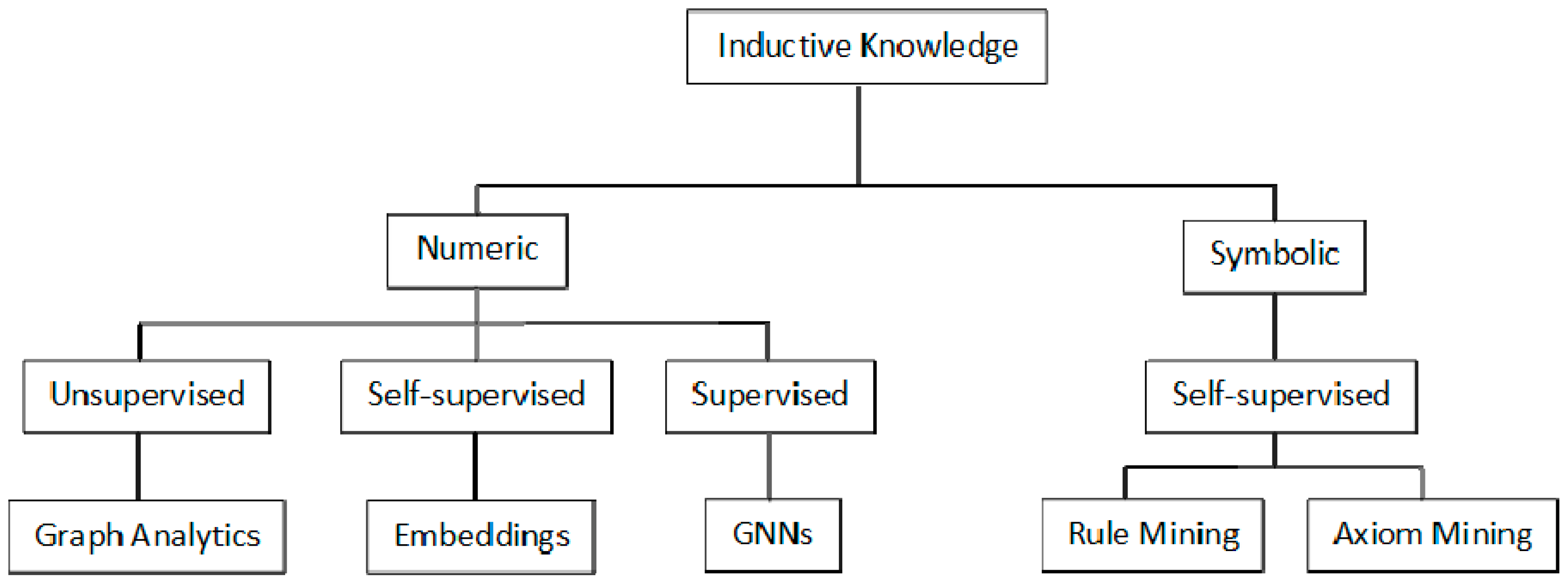


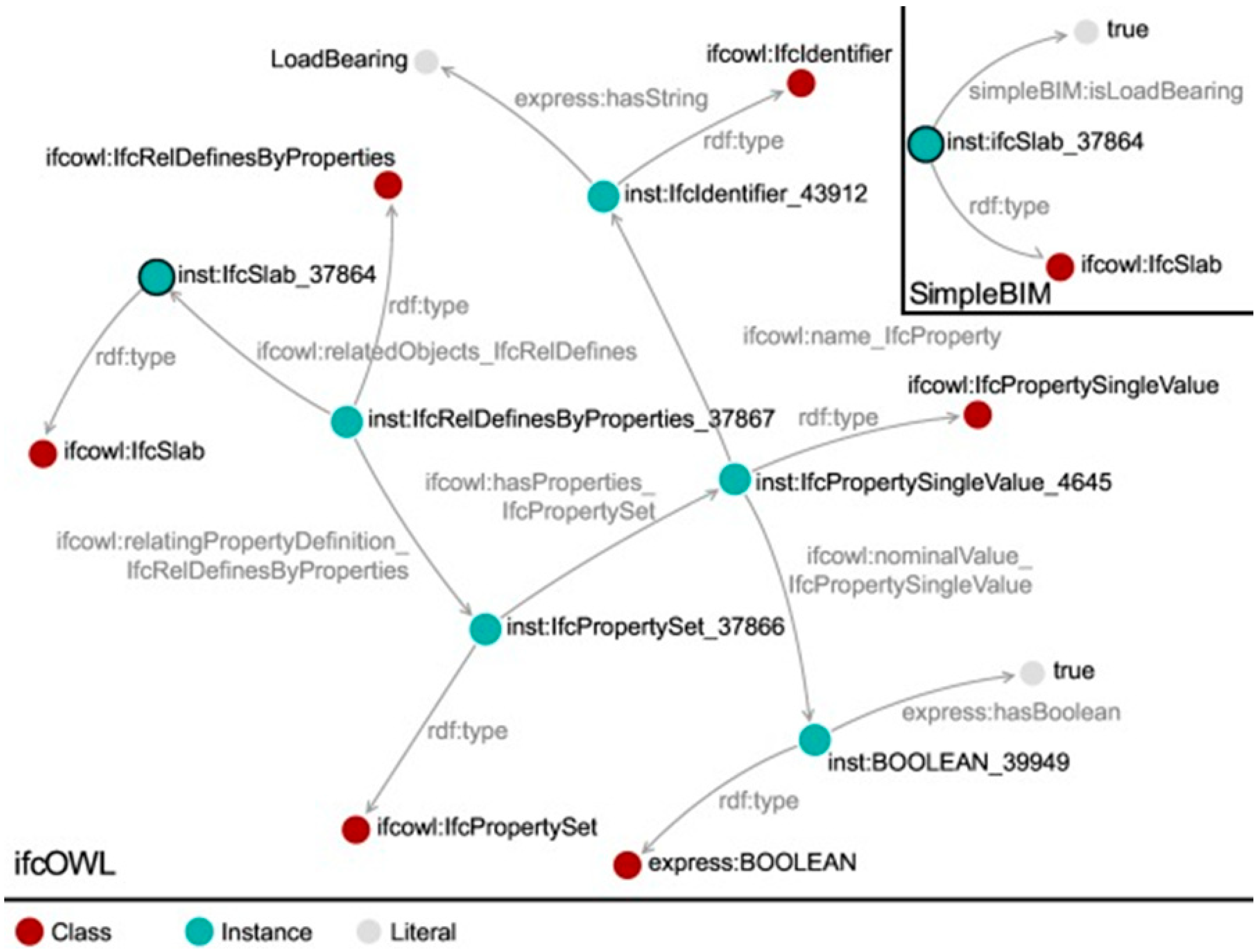
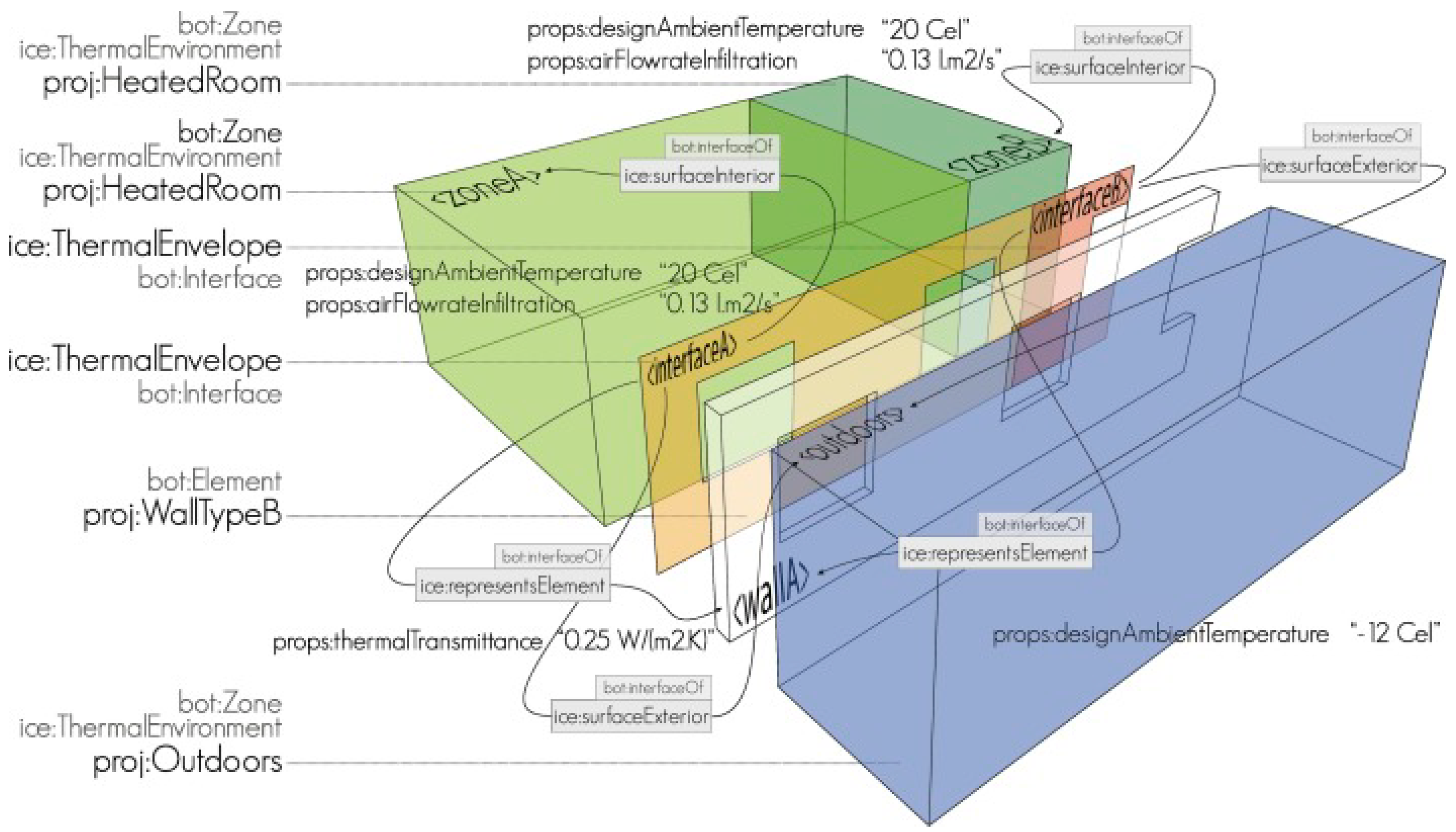
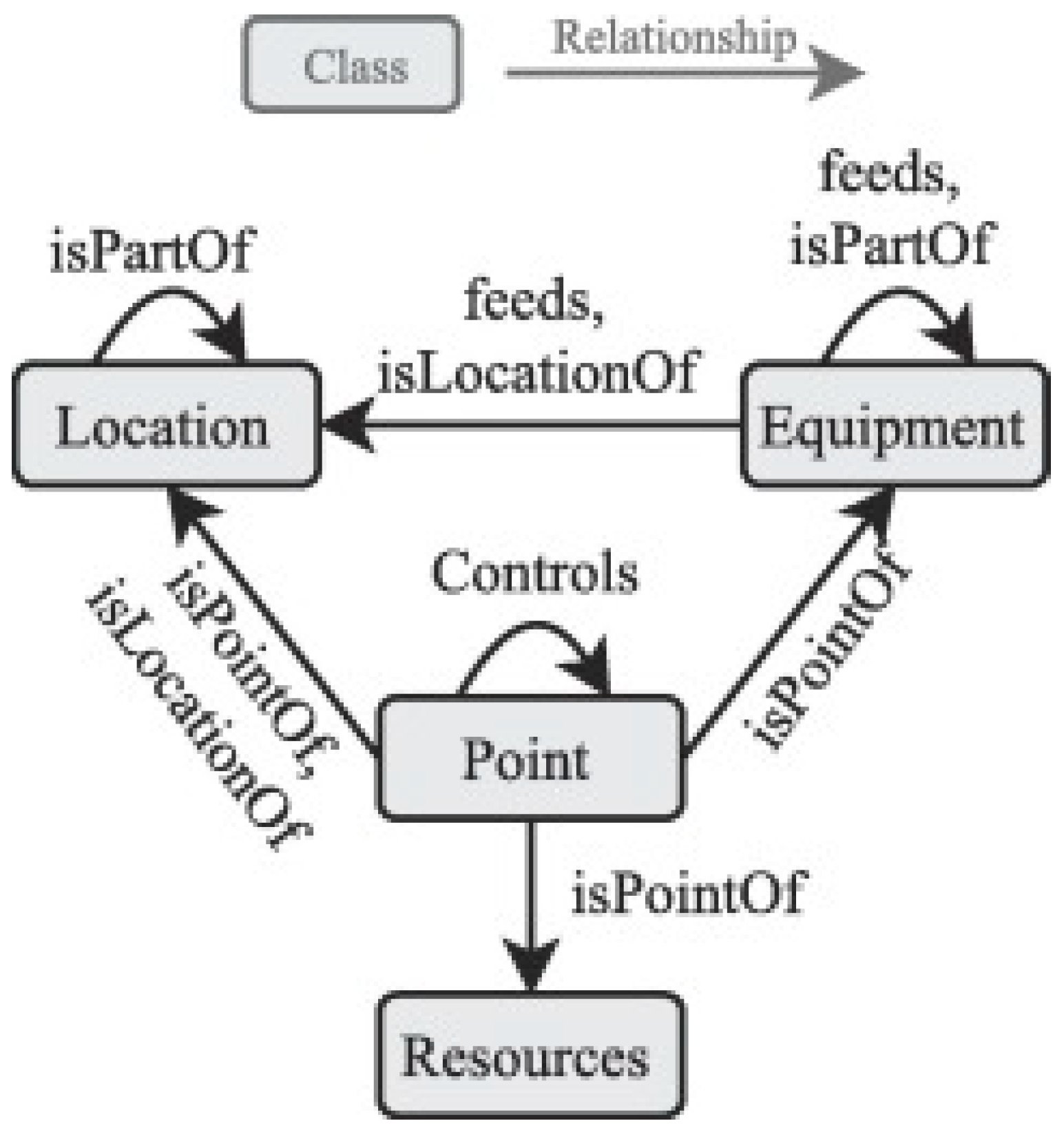
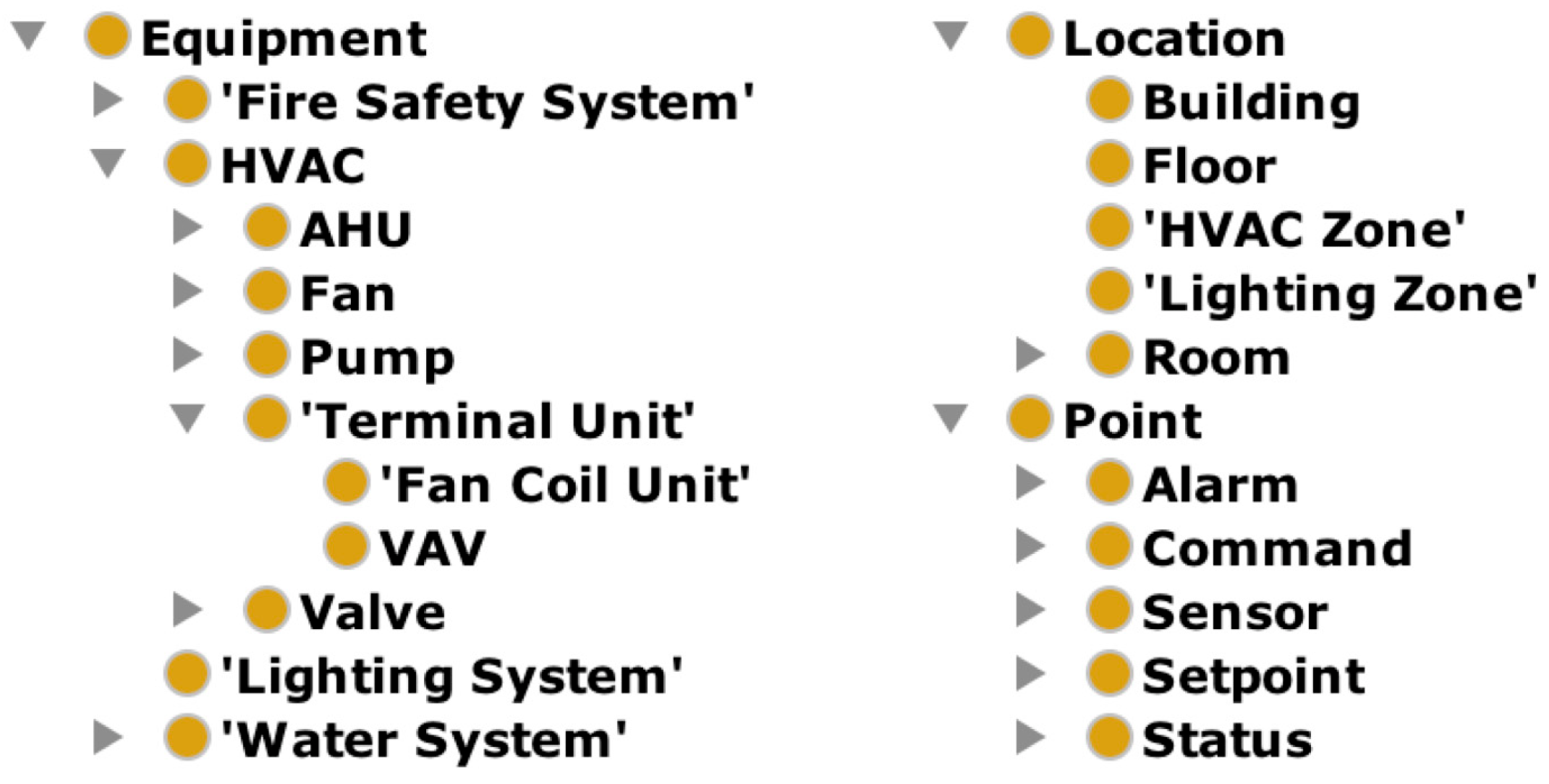
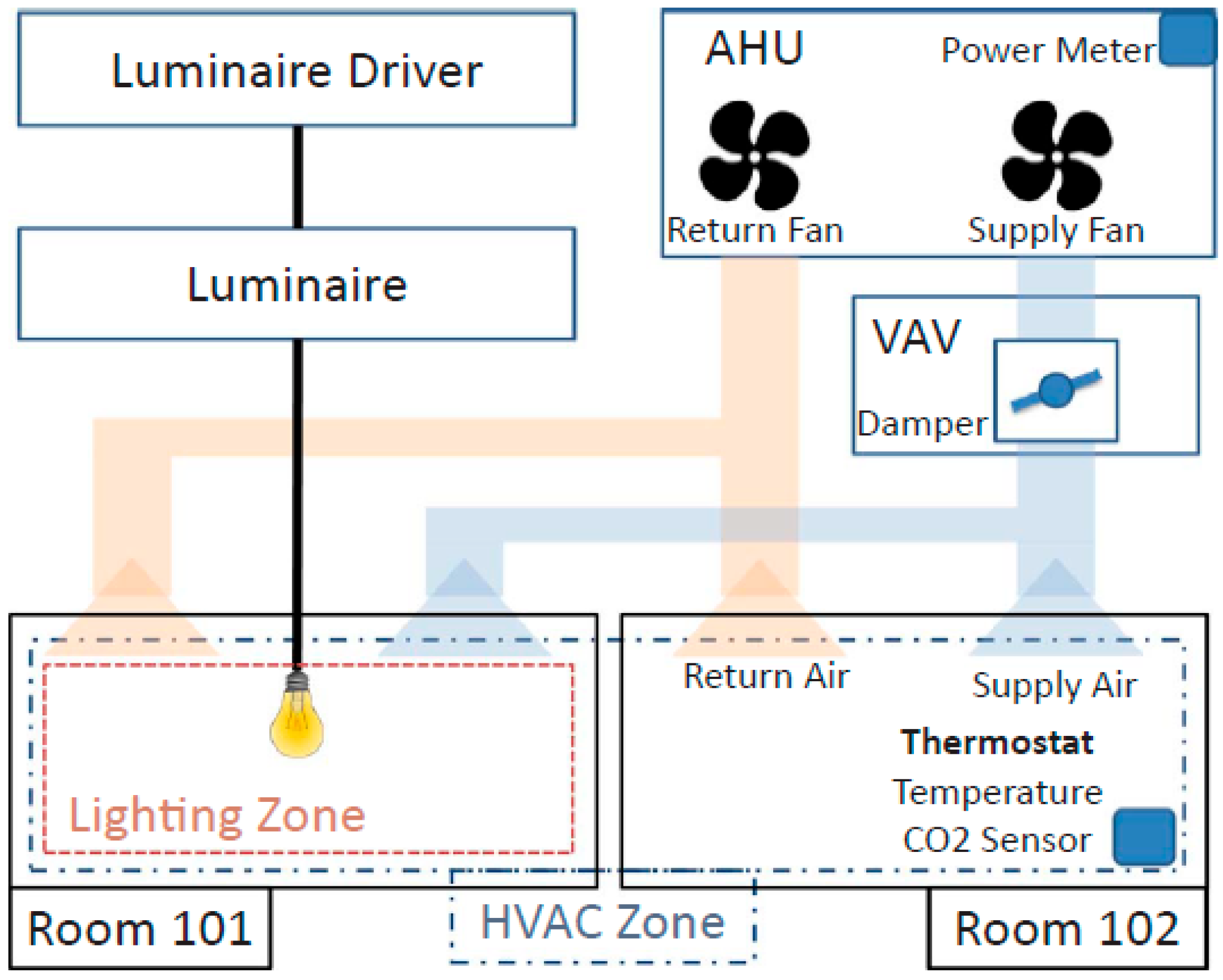
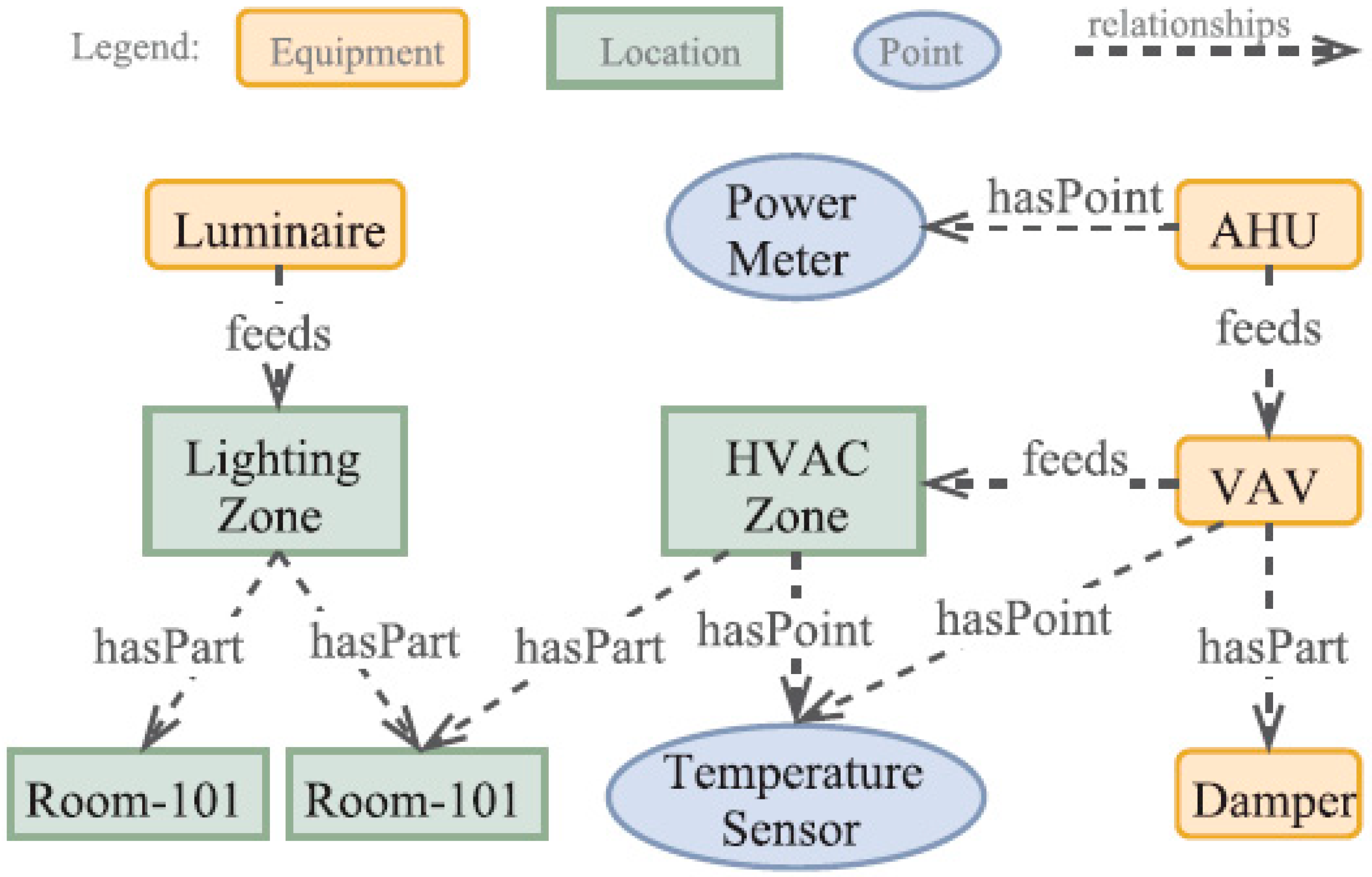
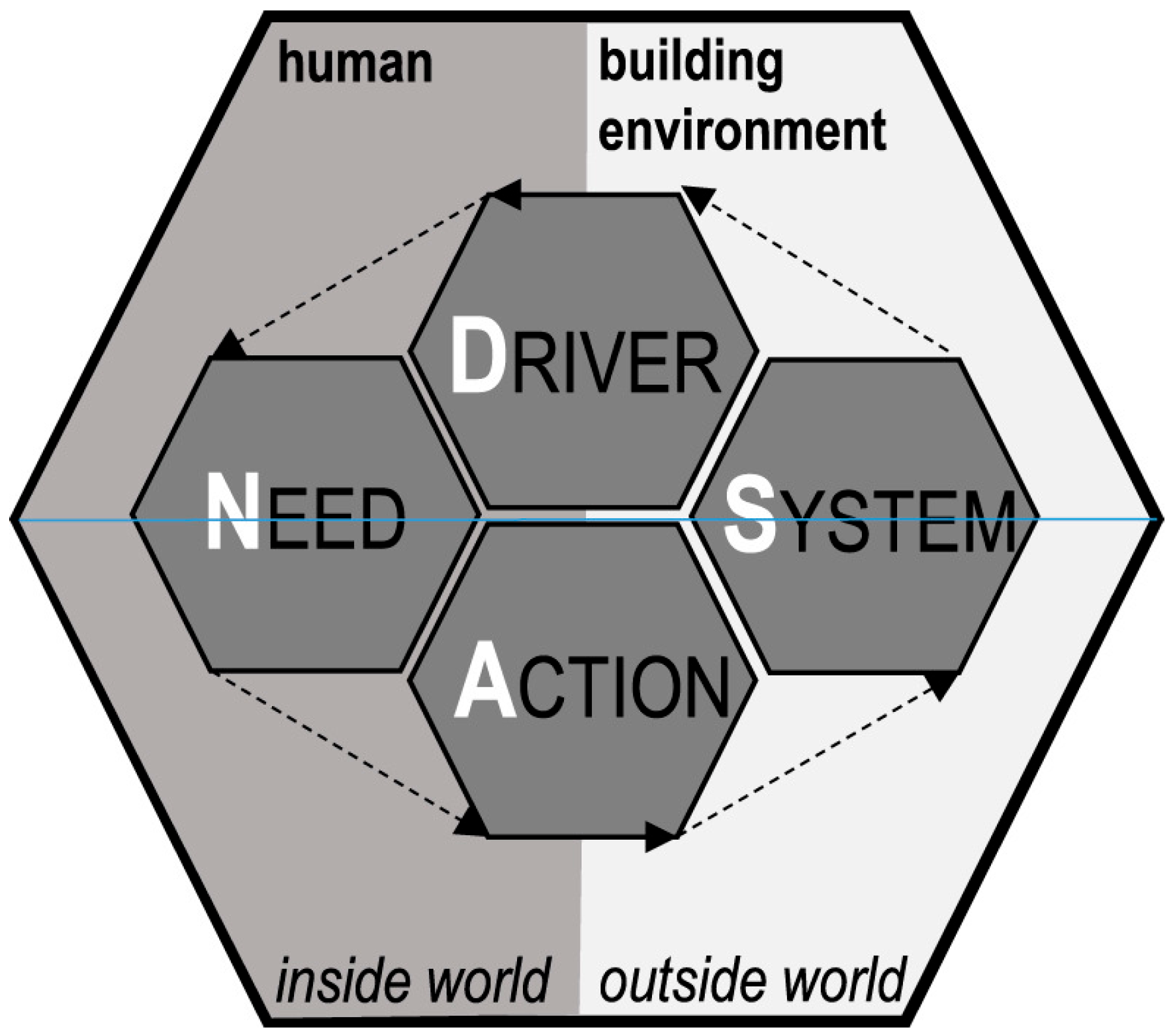
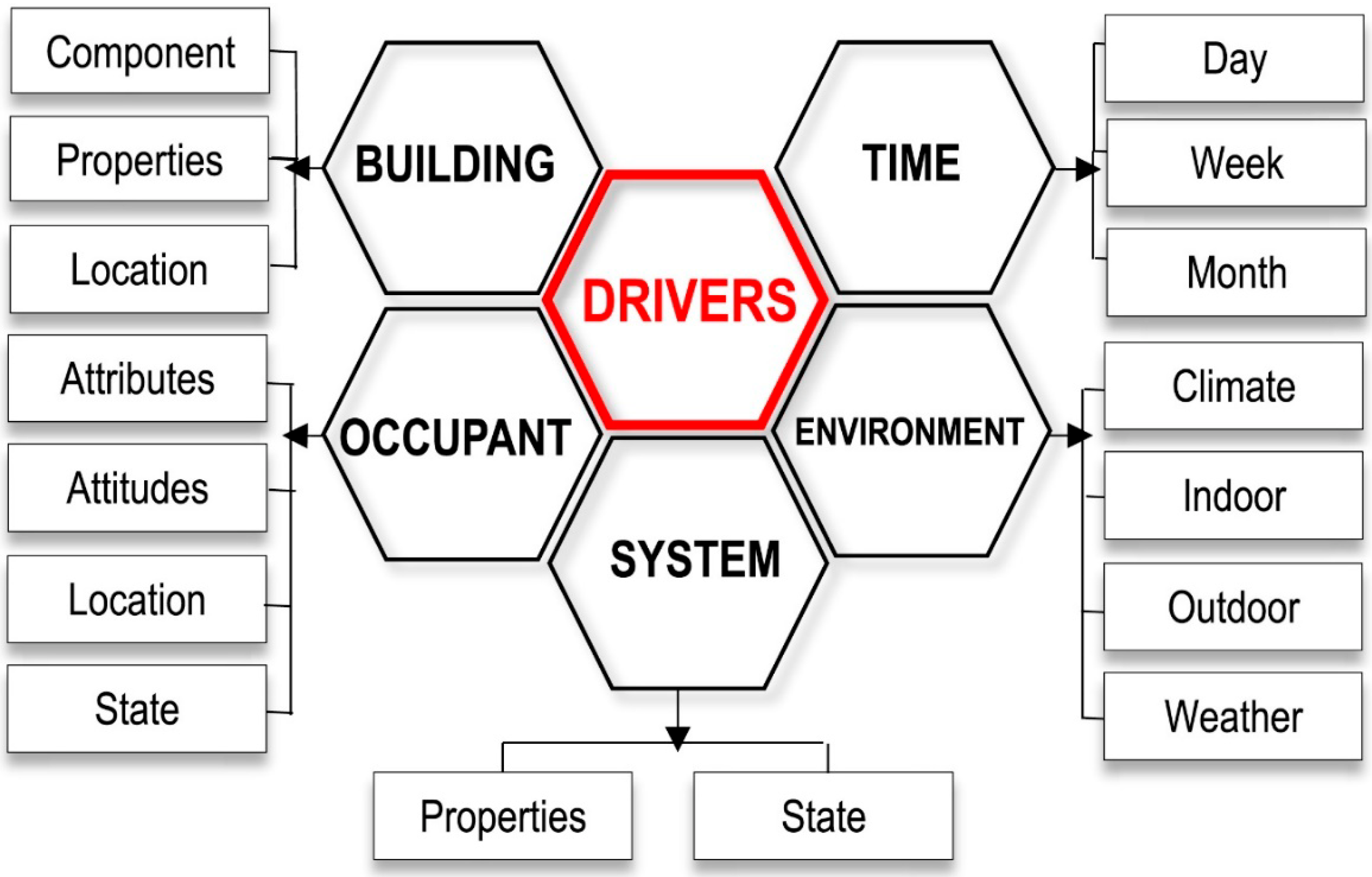
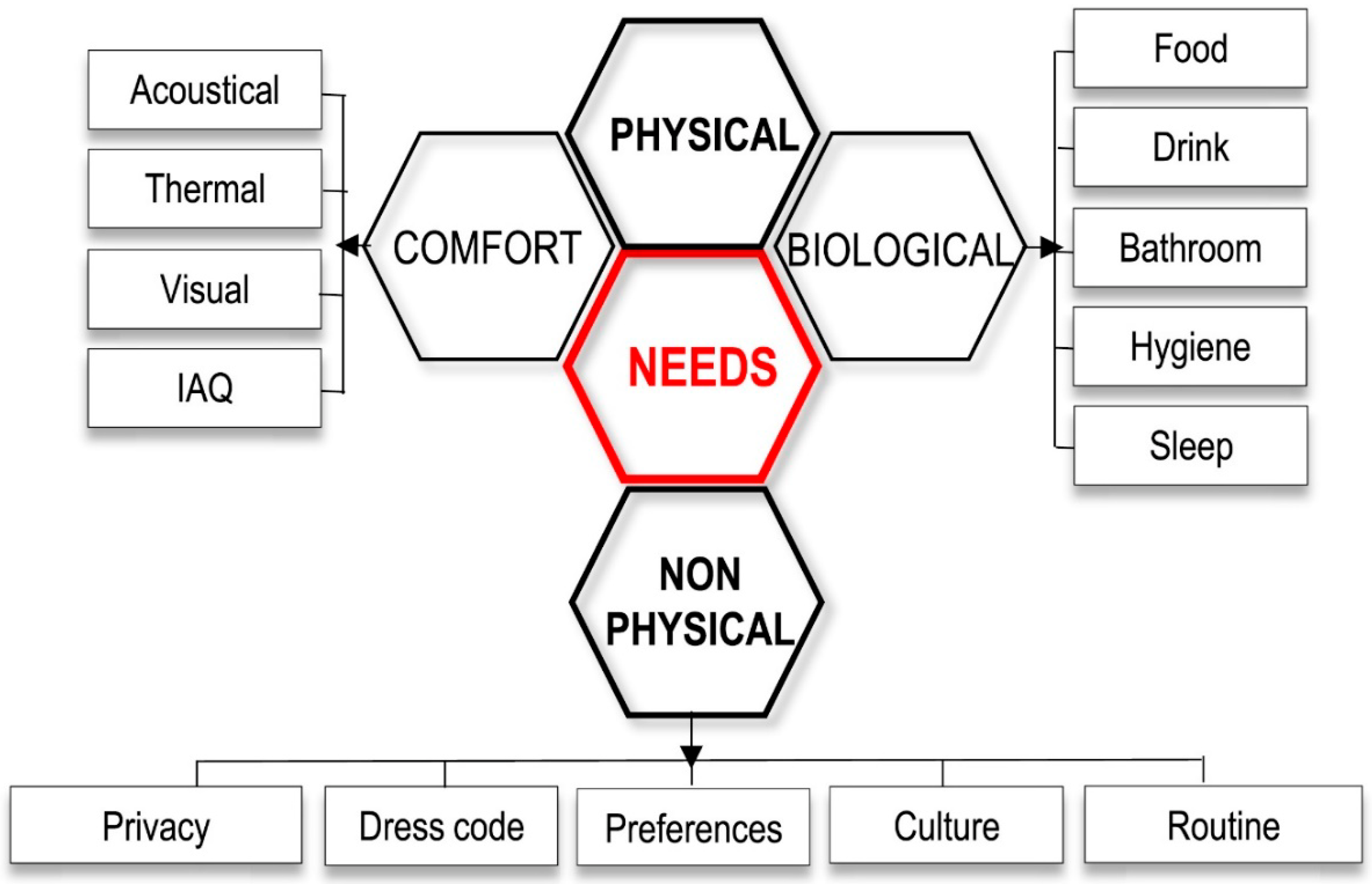


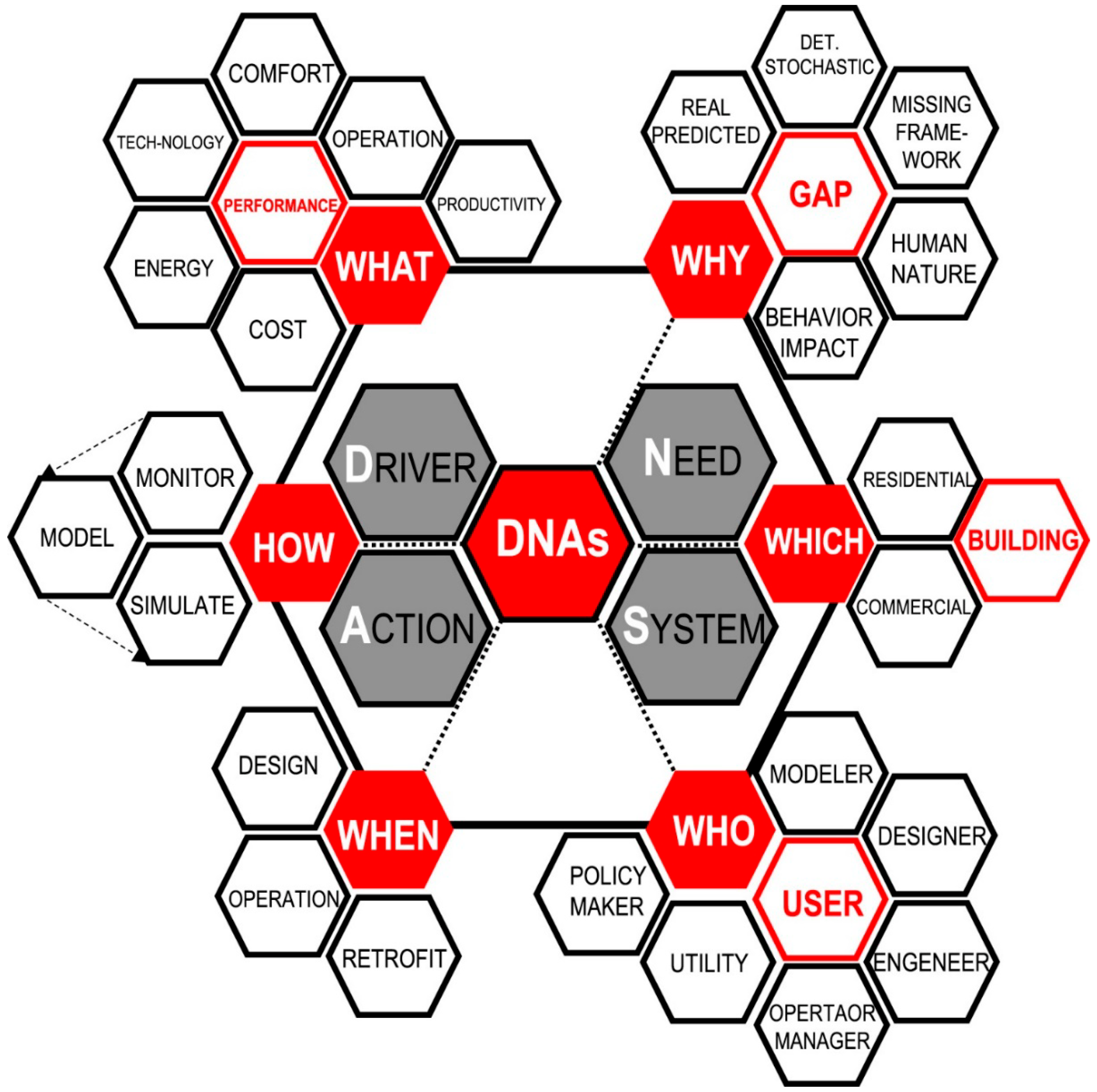
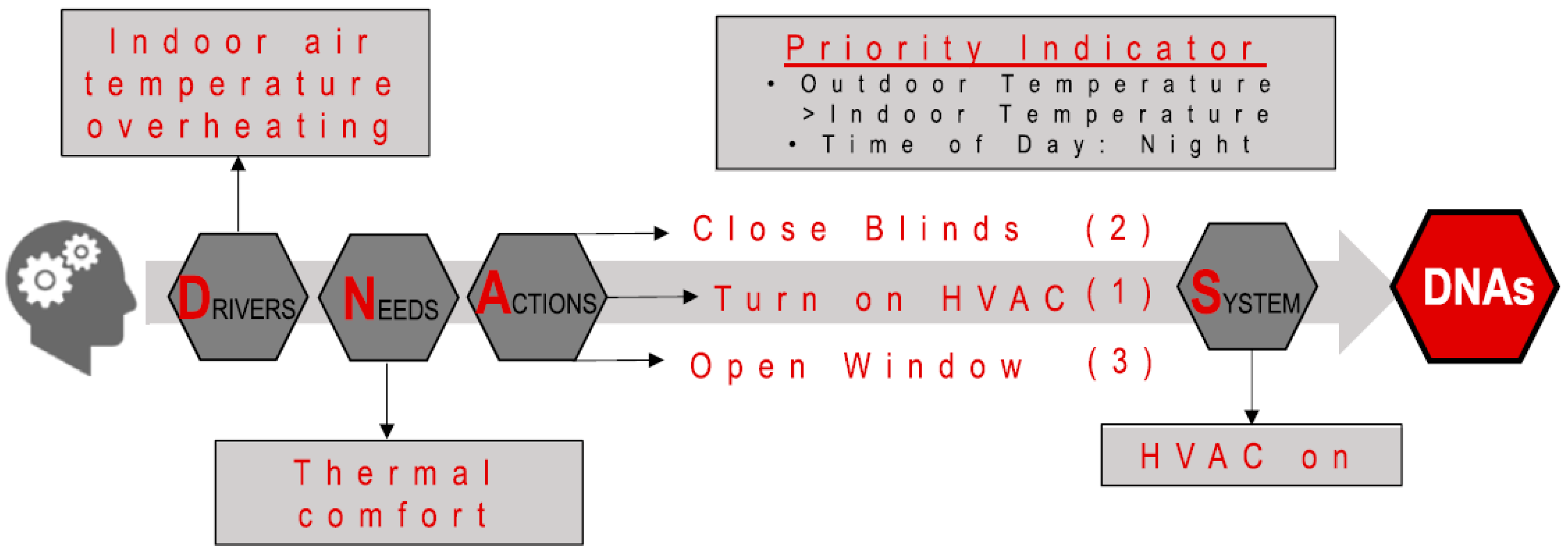
| Category | Name | Scope/Description | Year | Ref. |
|---|---|---|---|---|
| Building Design Phase | Industry Foundation Classes (IFC) | Gives spatial and other properties to every building entity | 2013 | [21] |
| ifcOWL | Descriptive OWL representation of IFC schema | 2016 | [75] | |
| simpleBIM | Simplified version of ifcOWL | 2017 | [116] | |
| Green Building XML (gbXML) | Information exchange between BIM and Models | 2000 | [21] | |
| Tubes | High-level description of building service systems | 2020 | [77] | |
| SimModel Ontology | Exchange of energy simulation data | 2014 | [78] | |
| EnergyADE | Exchange of energy simulation data | 2014 | [79] | |
| Smart Buildings | Semantic Sensor Network/Sensor, Observation, Sample, and Actuator (SSN/SOSA) | Focuses on sensors in buildings | 2011 | [81] |
| Web Thing Model (WoT) | Model to describe the virtual counterpart of physical objects in the Web of Things | 2015 | [82] | |
| oneM2M BaseOntology’s | Provide syntactic and semantic interoperability between oneM2M and external systems | 2016 | [83] | |
| One Data Model (OneDM) | Model to support a common language for the Internet of Things | 2018 | [84] | |
| Smart Energy Aware Systems | 2016 | [85] | ||
| ThinkHome | Ontology that includes concepts needed to realize energy efficient and intelligent control mechanisms | 2011 | [86] | |
| Building Ontology for Ambient Intelligence (BOnSAI) | A smart building ontology for ambient intelligence | 2012 | [87] | |
| DogOnt | Model for all devices being part of IoT inside a smart environment | 2008 | [88] | |
| Ontology of Smart Building (SBOnto) | Smart Building Ontology | 2017 | [89] | |
| Smart Applications REFerence (SAREF) | Matches existing assets in the smart applications domain | 2014 | [90] | |
| Project Haystack 3 | Hierarchical representation of buildings entities and concepts utilizing tagsets | 2014 | [91] | |
| BASont | Building Automation and Monitoring | 2012 | [92] | |
| Project Haystack 4 | Hierarchical representation of buildings entities and concepts utilizing tagsets | 2019 | [93] | |
| Haystack Tagging Ontology (HTO) | Streamlining Data from IoT based on Project Haystack | 2016 | [94] | |
| Brick Schema | Metadata and data points from building advancement and needs based on end-use applications | 2016 | [95] | |
| Google Digital Building Ontology | Represent structured information about buildings and building-installed equipment | 2020 | [96] | |
| Semantic BMS ontology (SBMS) | BAS-protocol-independent model of intelligent building systems | 2016 | [97] | |
| CTRLont | Model of Control Logic in Building Automation Systems | 2017 | [99] | |
| Green Button | Building Automation and Monitoring | 2011 | [98] | |
| RealEstateCore (REC) | Usage analysis and optimization and presence analysis of a building structure | 2017 | [101] | |
| Building Topology Ontology (BOT) | Representation of physical and conceptual objects of a building and the connections between them | 2019 | [102] | |
| Building Automation and Control Systems (BACS) | Supports the modeling control behavior in a BAS, physical devices of BAS and their location in the building and connection to technical equipment and appliances | 2017 | [103] | |
| Knowledge Model for City (KM4City) | Representation model for city and mobility | 2014 | [104] | |
| EM-KPI Ontology | Enhance energy management at district and building levels | 2017 | [105] | |
| Facility Smart Grid Information Model | An abstract information model of what the Smart Grid looks like from the perspective of a facility | 2014 | [106] | |
| RESPOND | Manage real-time optimal energy dispatching, considering all energy assets on site | 2020 | [107] | |
| Occupant Behavior -Centric | DNAs Framework (obXML) | Represent the impact of the behavior of occupants on the building’s energy efficiency | 2015 | [112] |
| Occupancy Profile (OP) Ontology | Semantic model for occupancy profile | 2020 | [109] | |
| Onto-SB | Human Profile Ontology for Energy Efficiency in Smart Building | 2018 | [110] | |
| OnCom | Occupant Thermal Comfort Optimization | 2019 | [111] | |
| Audits and Assets Management | Building Energy Data Exchange Specification (BEDES) | Data information gathering and storing based on building’s systems | 2014 | [113] |
| Virtual Buildings Information System (VBIS) | Classifies and connects asset data sources and systems | 2020 | [114] | |
| Ontology of Property Management (OPM) | Vocabulary for modeling complex assets in a building design environment | 2018 | [115] |
| Category | Scope | Architecture Used | Case Study | Year | Ref. |
|---|---|---|---|---|---|
| Energy Performance Improvement | Reduce the performance gap between the real and simulated data | ifcOWL, SimModel, SSN and custom | Use of simulated and measured KPIs to assess the thermal comfort conditions and the HVAC system performance | 2015 | [137] |
| Gather and prepare data streaming from various sources and calculate the building performance | RDF schema and custom ontology | Energy Performance assessment using real-time data streaming in a university building, assessed by building managers and engineers | 2017 | [138] | |
| Performance tracking at building and district level | ifcOWL, SimModel and SSN ontology | Nineteen solar houses microgrid | 2019 | [139] | |
| Building energy savings | RDF schema | Identify any energy waste in an office zone | 2015 | [140] | |
| Support of the selection for efficient and best-cost HVAC systems/the evaluation and prioritization of energy performance values (cooling/heating) consumption | InterfaceOnto | Design phase of an office building | 2015 | [143] | |
| Optimize the energy performance | SPORTE2 | Building Energy Performance Optimization of a swimming pool using ANN, Genetic Algorithms, real-time sensors and SWRL rules | 2014 | [156] | |
| Optimization problem generation on minimizing comfort dissatisfaction of building users regarding specific parameters and minimizing costs of energy consumption | Custom Ontology | Two office rooms are used to evaluate the scope of the ontology | 2017 | [157] | |
| Data Injection | Creation of a BIM-based system that automatically associates and updates thermal property measurements with BIM elements in a gbXML schema | gbXML | Two case studies that the method they proposed minimizes the gap between architectural information in BIM and the real data for energy performance simulation | 2015 | [148] |
| Use of gbXML schema to convert semantic information coming from raw point cloud data and use it into energy simulation tools | gbXML | Five existing buildings (three residential and two bank buildings) | 2015 | [149] | |
| Use of gbXML framework to store data from big buildings, like factories, in gbXML format, to make it easier to import into simulation tools | gbXML | University’s manufacturing facility | 2018 | [150] | |
| Facility Management | Provide modification options to facility managers | gbXML, EnergyPlus | Educational building application of real-time data in building energy simulation modifications | 2017 | [151] |
| Creation of semantic relationships between BMS data and building spaces | SSN/SONA and BOT ontologies | Educational building support of data analysis, lacking real-time data that was found to be a challenge in HVAC system control | 2018 | [152] | |
| BIM and BMS data connected with the semantic web to assist facility managers | - | - | 2018 | [153] | |
| Occupant Behavior-Centric | Targets the occupants in a building and makes suggestions to reduce building energy by their behavior | OPTIMUS, SSN/SONA, Urban Energy Ontology | Use of ontology to provide solutions in energy reduction and comfort increase based on the building’s assessment/application of ontology in a lab in Athens where the building’s energy was reduced in contrary to the year before the ontology was applied | 2018 | [144] |
| Modeling tool that takes into consideration occupant behavior | obFMU/DNAs, EnergyPlus | Coupled obFMU with EnergyPlus to model occupant behavior lighting control, to model occupant behavior window action and to model HVAC control | 2016 | [145] | |
| Reduce building energy consumption by having as top priority occupant behavior changes and covering their thermal comfort needs | Onto-SB | Residential building with four people, where they apply distinctive characteristics and after they integrate the mechanism that is proposed they conclude with a 40% energy consumption reduction | 2019 | [146] | |
| Efficient control of appliances and devices in smart buildings, targeting the occupants’ comfort and energy consumption reduction | Onto-SB | Reduce the energy consumption by altering distinctive characteristics in the scenario and make the simulation process quicker | 2020 | [147] | |
| Combination of a wireless sensor network and an emotional state analysis from occupants to calibrate indoor thermal comfort | OnCom | Assessing eleven participants with distinctive characteristics and each one responds to the system’s actions in a different situation with respect to the indoor thermal comfort and the results showed that the mean of users agreed with the system’s decisions | 2019 | [111] | |
| Decrease in Reused Ontologies | Context-awareness architecture for managing thermal energy in nZEBs | OWL, SWRL | Showing that SPARQL and Semantic Web Rule Language were compatible with decision making in a building | 2017 | [154] |
| Supports the modeling control behavior in a BAS, physical devices of BAS and their location in the building and connection to technical equipment and appliances | BACS, EXPRESS, OSPH, SSN/SOSA, BOT and FSM | Inclusion of a room and the automated control of the windows’ shades using SPARQL queries | 2017 | [155] |
Publisher’s Note: MDPI stays neutral with regard to jurisdictional claims in published maps and institutional affiliations. |
© 2022 by the authors. Licensee MDPI, Basel, Switzerland. This article is an open access article distributed under the terms and conditions of the Creative Commons Attribution (CC BY) license (https://creativecommons.org/licenses/by/4.0/).
Share and Cite
Lygerakis, F.; Kampelis, N.; Kolokotsa, D. Knowledge Graphs’ Ontologies and Applications for Energy Efficiency in Buildings: A Review. Energies 2022, 15, 7520. https://doi.org/10.3390/en15207520
Lygerakis F, Kampelis N, Kolokotsa D. Knowledge Graphs’ Ontologies and Applications for Energy Efficiency in Buildings: A Review. Energies. 2022; 15(20):7520. https://doi.org/10.3390/en15207520
Chicago/Turabian StyleLygerakis, Filippos, Nikos Kampelis, and Dionysia Kolokotsa. 2022. "Knowledge Graphs’ Ontologies and Applications for Energy Efficiency in Buildings: A Review" Energies 15, no. 20: 7520. https://doi.org/10.3390/en15207520
APA StyleLygerakis, F., Kampelis, N., & Kolokotsa, D. (2022). Knowledge Graphs’ Ontologies and Applications for Energy Efficiency in Buildings: A Review. Energies, 15(20), 7520. https://doi.org/10.3390/en15207520







